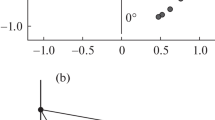Abstract.
The aim of the present study was to simulate the input system and the motoneuron (MN) pool of the MN pool–muscle complex (MNPMC). Input fibers, which can originate from command centers in the central nervous system or from sensory organs, activate the MN pool. They generate sequences of action potentials, the frequency of which is proportional to a time-dependent activation factor (which is an input to the model). Different connection patterns between the input fibers and motor units (MUs) are allowed. For simplicity and since no precise experimental data are available, 70 input fibers and 4 boutons per fiber and MN are simulated (this corresponds approximately to the monosynaptic group-Ia input of the cat medial gastrocnemius muscle). Each bouton generates the same conductance change in the postsynaptic membrane. The MNs are modeled with a single compartment and a homogenous membrane. According to experimental data, the membrane leakage conductance and capacitance are MU dependent. Since the precise relation is unknown: (a) the computed relation between MU contraction force and the MN leakage conductance was taken from a steady-state MNPMC model, and (b) the capacitance was assumed to be proportional to the leakage conductance. The MN membrane includes time- and voltage-dependent ionic channels (fast and slow K+ and low- and high-threshold Ca2+ channels). The density and time constant of the slow K+ channels and the density of the Ca2+ channels were fitted to approximate afterhyperpolarization characteristics and frequency-injected current relations of type-identified cat MNs. If the membrane reaches a voltage threshold the MNs generate action potentials, which were simulated by voltage pulses. The activation of the MN pool of the human first dorsal interosseus muscle was simulated with injected and synaptic currents in order to illustrate the size principle, synaptic noise, and other features of muscle activation. It is concluded that the present model reproduces the main properties of the input–output relations of different MN types within a muscle. Together with the simulation of the muscle force and the surface EMG, which will be published in subsequent papers, it will be a powerful tool for reproducing experiments on the motor system and investigating functional mechanisms of motor control.
Similar content being viewed by others
Author information
Authors and Affiliations
Additional information
Received: 17 April 2001 / Accepted in revised form: 6 November 2001
Rights and permissions
About this article
Cite this article
Nussbaumer, R., Ruegg, D., Studer, L. et al. Computer simulation of the motoneuron pool–muscle complex. I. Input system and motoneuron pool. Biol Cybern 86, 317–333 (2002). https://doi.org/10.1007/s00422-001-0295-9
Issue Date:
DOI: https://doi.org/10.1007/s00422-001-0295-9




